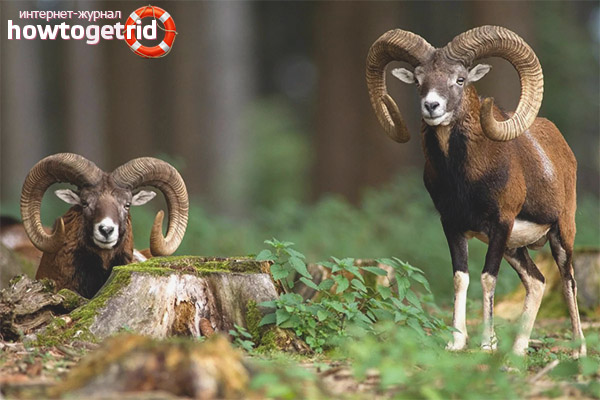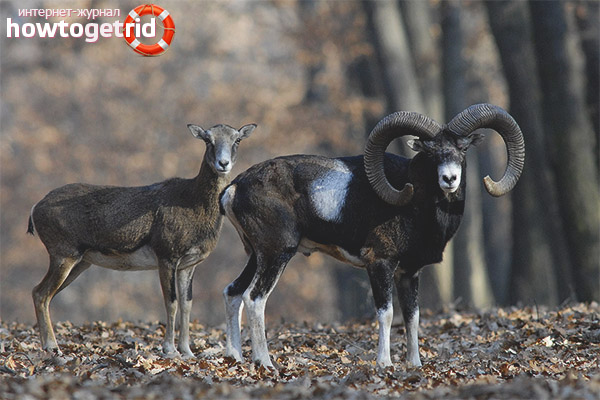The content of the article
Mouflon is a cloven-hoofed ruminant of the genus of rams. He is considered one of the two ancestors of all modern domestic sheep. Despite their impressive appearance (the merit is their stunning horns), the mouflon is actually one of the smallest sheep species found in the wild.
Mouflon Description
The males of this extremely careful wild sheep have large crescent-shaped horns, which are valued by many hunters and are considered trophies. The size of the status of the animal within the group depends on their size. Larger horns determine the male higher dominance. In most subspecies, females also have horns, but they are much smaller than in males. In some populations, most females do not grow horns.
An adult male mouflon is not too large. Its shoulder height is about 0.75 m; length - 1.2-1.4 m, tail length - about 10 cm; the head is small; a mature male has highly developed horns, bent by almost one revolution, about 40 cm long. The weight of an adult male is up to 50 kg. The mouflon female is slightly lighter and less, its weight is about 35 kg.
The mouflon has muscular legs and a squat body that helps him move around steep terrain. The head of the animal is well balanced and proportional to its body. The breed standard says that he should keep his head high when he is on the alert.
In various subspecies of the mouflon, the overall appearance differs slightly; color varies depending on the season, as well as between males and females. The nose and the inside of the ears are usually white. The legs are long and slender with a vertical black line below the knees. The mouflon has a white belly and coat, which varies in color from gray with a reddish tint to brown and coffee, while the male European mouflon is dark chestnut and the females are beige.
Adult rams typically develop a substantial pectoral ruffe of long coarse hair, which tends to be white in the throat, turning to black when it extends to the forelimbs. In most subspecies, mouflon males also have a lighter saddle spot that develops and grows in size as they grow older, and a black stripe that begins at half the nape, lasts along the shoulders, continues under the body and ends on the hind legs. Mouflon has large glands under the eyes, which often exude a sticky substance.
Habitat
As a rule, mouflons live in mountainous areas with meadows and deserts, although in Europe mouflons have also been introduced in forest areas. They can be found at an altitude of 3000 meters above sea level. They prefer the gentle slopes of high mountain ranges with a reasonable amount of cover, and use steep, steep areas to avoid predators.
Mouflon lifestyle

Mouflons, as a rule, eat early in the morning and in the evening, resting during the day under an overhanging bush or rock, where they are well hidden.These individuals are herd animals that form non-territorial herds grazing on grasses. If food is scarce, then they feed on leaves and fruits. Their feelings are well developed as the sheep depend on early detection and flight from approaching predators, especially the leopard, jackal and wolf.
Mouflons reach puberty at about three years of age, although males are unlikely to breed up to four years in populations with low hunting pressure. Females usually give birth to one lamb (sometimes twins). Females with lambs stick together in herds of up to one hundred individuals, males walk alone, they return to the herd only in the mating season.
In the summer, mouflons live in a strip of mixed forests, where they find, in addition to food, also a shadow. These rams are nomadic species that often travel in search of new places to eat. In winter, they migrate to warmer heights to avoid very low temperatures and food shortages.
Mouflon is an animal leading a nocturnal lifestyle. They graze only at night, going out onto the lawns near the forest. All day they hide in the forest, and in the evening they leave daytime shelters in search of food. Mouflons graze all night, and in the morning they hide again in the forest.
What do they eat
In summer, mouflons feed on vegetation that grows in their habitats. First of all, they eat grass, and if it is not enough, they switch to the green leaves of shrubs. In winter, they feed on parts of plants that they find on top of the snow; they do not know how to look for dry grass in the snow. Females usually have better feeding places, because their health is very important for breeding. During this period of the year, they feed on branches of bushes sticking out from under the snow, shoots of trees, wood lichens and dried grass.
Mouflon Reproduction
Mouflons are polygynous, males fight among themselves to achieve dominance and win the opportunity to mate with females. The dominance of a ram depends on its age, and how large its horns are. Fights between rams over their harem of ewes rarely cause serious injuries, and the winner does not commit any further attacks.
Mouflons reach puberty at the age of about 1.5 years. Females already in the 2nd year of life can be fertilized, and at the age of 2 years they can bring the first lamb. Males begin to mate a little later - at the age of 3-4 years. At an earlier age they are driven away from females by mature males. They mate from autumn to early winter.
Pregnancy lasts about 210 days, and in April, one to two lambs are born. The female leaves the herd before lambing to give birth in a secluded place. A newborn lamb can immediately stand on its feet for several minutes, and soon after birth begins to run. The lamb remains closely attached to its mother, eating every 10-15 minutes. When the lambs get stronger, the females return to the herd. Since males are unfriendly to lambs, females avoid them.
The number of mouflons is declining today and they are classified as vulnerable in the list of endangered species. European mouflons live in wild conditions up to 8 years, and in zoos - up to 14, sometimes even up to 18 years old (under favorable conditions).
The benefits and harms of mouflons
For people, mouflons pose no danger. In breeding very often use the European breed. On its basis, breeds of domestic sheep were bred, capable of grazing on mountain pastures year-round. European mouflon leather is used in light industry, and its meat has good taste.
Demographic threats
Mouflons are threatened by the expansion of agriculture and farming, which leads to a reduction in their numbers and the division into small, disparate groups. Excessive grazing within their range, due to the expansion of sheep breeding, led to erosion, which in turn led to a reduction in the suitable habitat of this species.
Parasites and contagious diseases of livestock, especially domestic sheep, pose a serious threat in many areas. Poachers prey on adult sheep because of the value of their horns as trophies, and at birth they sometimes lure lambs to make pets.
Mouflons are often imported for use on North American game ranches, but purebred mouflons are rarely hunted, usually the breed is crossed with domestic sheep to create more exotic and unique trophy rams for hunters.
Video: mouflon (Ovis orientalis)











Submit